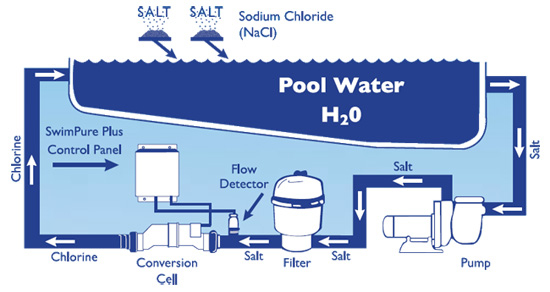Salt Chlorine Generators

Salt Chlorine Generators use ordinary salt(sodium chloride) and electrolysis to produce Sodium Hypochlorite(bleach) in order to sanitize the pool water.
You may have heard someone comment that a pool they visited was a saltwater pool, and the swimming
experience was so good because the pool did not use chlorine. They may have mentioned that the water
felt softer, and that they did not experience common issues with pools such as eye or skin irritation.
While the experience they had is slightly accurate, there is a misconception about why they had such a
comfortable experience in the water.
The number one mistake people make when referring to a saltwater pool is the mention that it is not a
chlorine pool. They definitely are chlorine pools it’s just the manner in which the chlorine is introduced
into the water is different. Salt Chlorine Generators use ordinary salt(sodium chloride) and electrolysis
to produce Sodium Hypochlorite(bleach) in order to sanitize the pool water. While the chlorine no
longer needs to be added to the water manually, the proper residual of salt needs to be maintained
in order to maintain a stable chlorine concentration. The amount of salt varies based on pool water
volume and chlorine demand, but can be added to the pool in amounts as little as one teaspoon per
1,000 gallons of pool volume. It is important to note that concentration of salt in the water is small
enough to where there is no salt taste to the water. The level of salt will remain constant unless the pool
water is diluted through regular backwashing of the filters and the addition of make-up water.
The Salt Chlorine Generator uses a cell that is mounted on the return line of the recirculation system,
either directly inline or by use of a bypass manifold. The cell is powered by a control unit, and maintains
a constant and steady level of chlorine that helps eliminate and reduce the negative effects of using
manually-added chlorine in the water. As the chlorine is depleted and turns into salt, the generator
will again convert the salt back into chlorine. This prevents the formation of chloramines, which
are primarily responsible for eye and skin irritation, chlorine odor, and cloudiness in the water. The
elimination of the need to manually add chlorine also prevents operator error, specifically in regard
to over or under-feeding the sanitizer. It is important to note that other chemicals will still need to be
added manually for maintaining stabilizer levels and water balance.
So would a salt chlorine generator be a good fit for your pool? It is basically a matter of personal choice.
The initial investment for a Salt Chorine system may be expensive, but makes seasonal maintenance
a bit easier. Maintaining a constant and steady level of chlorine in your pool will help prevent cloudy
water conditions and algae growth, as well as provide greater swimmer comfort. Current technological
advancement has helped decrease the cost of such systems, as well as increase the life of conversion
cells. An individual cost analysis for your pool in regard to chemical expense associated with seasonal
operation may help you make the decision.








